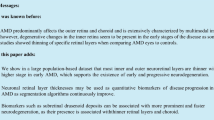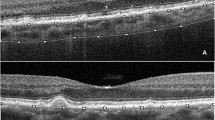Abstract
Background
Peripapillary retinal nerve fiber layer (pRNFL) and internal macular layer thinning have been demonstrated in Alzheimer’s disease (AD) with optical coherence tomography (OCT) studies. The purpose of this study is to compare the pRNFL thickness and overall retinal thickness (RT) in AD patients with non-AD patients, using spectral domain optical coherence tomography (SD-OCT) and determine the sectors most characteristically affected in AD.
Methods
A cross-sectional study was performed to determine the pRNFL and overall macular RT thicknesses in AD and non-AD patients, attending a tertiary hospital center. For pRNFL, the global and six peripapillary quadrants were calculated, and for overall RT values, the nine Early Treatment Diabetic Retinopathy Study (ETDRS) areas were used. A multiple regression analysis was applied to assess the effects of disease, age, gender, spherical equivalent, visual acuity, intraocular pressure, axial length and blood pressure on pRNFL and overall macular RT.
Results
A total of 202 subjects, including 50 eyes of 50 patients with mild AD (mean age 73.10; SD = 5.36 years) and 152 eyes of 152 patients without AD (mean age 71.03; SD = 4.62 years). After Bonferroni correction, the pRNFL was significantly thinner for the AD group globally and in the temporal superior quadrant (10.76 μm and 20.09 μm mean decrease, respectively). The RT thickness was also decreased in superior sectors S3 and S6 (mean thinning of 9.92 μm and 11.65 μm, respectively). Spearman’s correlation coefficient showed a direct association between pRNFL in the temporal superior quadrant and RT in superior S6 and S3 sectors (rS = 0.41; p < 0.001 and rS = 0.28; p < 0.001, respectively).
Conclusions
Patients with AD showed a significant thickness reduction in global and temporal superior quadrants in pRNFL and in superior pericentral and peripheral sectors of RT. These findings may reflect a peripapillary and retinal changes characteristic of AD, suggesting the importance of SD-OCT as a potential adjuvant in early diagnosis of AD. Further studies are needed to understand which retinal layers and macular sectors are more useful as potential ocular biomarker over time in AD.


Similar content being viewed by others
References
Association A (2012) 2012 Alzheimer ’ s disease facts and figures. Alzheimer’s Dementia 8:131–168. doi:10.1016/j.jalz.2012.02.001
Perl DP, Perl DP (2010) Neuropathology of Alzheimer ’ s Disease Address Correspondence to : 32–42. doi: 10.1002/MSJ
Burns A, Iliffe S (2009) Alzheimer’s disease. BMJ 338:b158. doi:10.1136/bmj.b158
Querfurth HW, LaFerla FM (2010) Alzheimer’s disease. N Engl J Med 362:329–344. doi:10.1056/NEJMra0909142
Hinton DR, Sadun AA, Blanks JC, Miller CA (1986) Optic-nerve degeneration in Alzheimer’s disease. N Engl J Med 315:485–487. doi:10.1056/NEJM198608213150804
Hinton DR, Sadun AA, Blanks JC, Miller CA (2010) Optic nerve degeneration in Alzheimer’s disease. N Engl J Med 315:485–487
Blanks JC, Torigoe Y, Hinton DR, Blanks RHI (1996) Retinal pathology in Alzheimer’s disease. I. Ganglion cell loss in foveal/parafoveal retina. Neurobiol Aging 17:377–384. doi:10.1016/0197-4580(96)00010-3
Blanks JC, Hinton DR, Sadun AA, Miller CA (1989) Retinal ganglion cell degeneration in Alzheimer’s disease. Brain Res 501:364–372
Parisi V, Restuccia R, Fattapposta F, et al (2001) Morphological and functional retinal impairment in Alzheimer’s disease patients. 112:1860–1867
Berisha F, Feke GT, Trempe CL, et al (2007) Retinal Abnormalities in Early Alzheimer ’ s Disease. 48:6–10. doi: 10.1167/iovs.06-1029
Hedges TR, Perez Galves R, Speigelman D et al (1996) Retinal nerve fiber layer abnormalities in Alzheimer’s disease. Acta Ophthalmol Scand 74:271–275
Tsai C, Ritch R, Schwartz B et al (1991) Optic nerve head and nerve fiber layer in Alzheimer’s disease. Arch Ophthalmol 109:199–204
Danesh-Meyer HV, Birch H, Ku JY et al (2006) Reduction of optic nerve fibers in patients with Alzheimer disease identified by laser imaging. Neurology 67:1852–1854
Iseri PK, Tokay T (2006) Relationship between Cognitive Impairment and Retinal Morphological and Visual Functional Abnormalities in Alzheimer Disease. 26:18–24
Kirbas S, Turkyilmaz K, Anlar O et al (2013) Retinal nerve fiber layer thickness in patients with Alzheimer disease. J Neuroophthalmol 33:58–61. doi:10.1097/WNO.0b013e318267fd5f
Salobrar-garcia E, Hoz R De, Rojas B, et al (2015) Findings in Mild Alzheimer ’ s Disease. 2015:17–19. doi: 10.1155/2015/736949
Ascaso FJ, Cruz N, Modrego PJ, Cristo A (2014) Retinal alterations in mild cognitive impairment and Alzheimer ’ s disease : an optical coherence tomography study. 1522–1530. doi: 10.1007/s00415-014-7374-z
Moschos M, Markopoulos I, Chatziralli I et al (2012) Structural and functional impairment of the retina and optic nerve in Alzheimer’s disease. Curr Alzheimer Res 9:782–788. doi:10.2174/156720512802455340
Gao L, Liu Y, Li X et al (2015) Abnormal retinal nerve fiber layer thickness and macula lutea in patients with mild cognitive impairment and Alzheimer ’ s disease. Arch Gerontol Geriatr 60:162–167. doi:10.1016/j.archger.2014.10.011
Williams MA, Mcgowan AJ, Cardwell CR et al (2015) Retinal microvascular network attenuation in Alzheimer ’ s disease. Alzheimer’s Dement Diagnosis, Assess Dis Monit 1:229–235. doi:10.1016/j.dadm.2015.04.001
Marziani E, Pomati S, Ramolfo P, et al (2016) Evaluation of Retinal Nerve Fiber Layer and Ganglion Cell Layer Thickness in Alzheimer ’ s Disease Using Spectral- Domain Optical Coherence Tomography. doi: 10.1167/iovs.13-12046
Ong Y, Ong Y, Ikram MK, et al (2014) Potential Applications of Spectral-Domain Optical Coherence Tomography ( SD-OCT ) in the Study of Alzheimer ’ s Disease. 23:74–83
Garcia-Martin ES, Rojas B, Ramirez AI et al (2014) Macular Thickness as a Potential Biomarker of Mild Alzheimer’s Disease. Ophthalmology 121:1149–1151.e3. doi:10.1016/j.ophtha.2013.12.023
Group ETDRSR (1991) Early Photocoagulation for Diabetic Retinopathy. Ophthalmology 98:766–785. doi:10.1016/S0161-6420(13)38011-7
Salobrar-Garcia E, Hoyas I, Leal M, et al (2015) Analysis of Retinal Peripapillary Segmentation in Early Alzheimer ’ s Disease Patients. doi: 10.1155/2015/636548
Ozdemir E, Eda O, Seda D (2015) The relationship between the degree of cognitive impairment and retinal nerve fiber layer thickness. Neurol Sci:1141–1146. doi:10.1007/s10072-014-2055-3
Bambo MP, Garcia-Martin E, Pinilla J et al (2014) Detection of retinal nerve fiber layer degeneration in patients with Alzheimer’s disease using optical coherence tomography: searching new biomarkers. Acta Ophthalmol 92:e581–e582. doi:10.1111/aos.12374
Paquet C, Roger F, Dighiero P, et al (2007) Abnormal retinal thickness in patients with mild cognitive impairment and Alzheimer ’ s disease. 420:97–99. doi: 10.1016/j.neulet.2007.02.090
Kesler A, Vakhapova V, Korczyn AD et al (2011) Retinal thickness in patients with mild cognitive impairment and Alzheimer ’ s disease. Clin Neurol Neurosurg 113:523–526. doi:10.1016/j.clineuro.2011.02.014
Tzekov R, Mullan M (2014) Vision function abnormalities in Alzheimer disease. Surv Ophthalmol 59:414–433. doi:10.1016/j.survophthal.2013.10.002
Coppola G, Renzo A Di, Ziccardi L, Martelli F (2015) Optical Coherence Tomography in Alzheimer ’ s Disease : A Meta-Analysis. 1–14. doi: 10.1371/journal.pone.0134750
Cunha JP, Moura-Coelho N, Proença RP, et al (2016) Alzheimer’s disease: A review of its visual system neuropathology. Optical coherence tomography—a potential role as a study tool in vivo. Graefe’s Arch Clin Exp Ophthalmol. doi: 10.1007/s00417-016-3430-y
Thomson KL, Yeo JM, Waddell B et al (2015) A systematic review and meta-analysis of retinal nerve fiber layer change in dementia, using optical coherence tomography. Alzheimer’s Dement Diagnosis, Assess Dis Monit 1:136–143. doi:10.1016/j.dadm.2015.03.001
He X-F, Liu Y-T, Peng C et al (2012) Optical coherence tomography assessed retinal nerve fiber layer thickness in patients with Alzheimer’s disease: A meta-analysis. Int J Ophthalmol 5:401–405. doi:10.3980/j.issn.2222-3959.2012.03.30
Cheung CY, Ting Y, Ikram MK et al (2014) Microvascular network alterations in the retina of patients with Alzheimer ’ s disease. Alzheimer’s Dement 10:135–142. doi:10.1016/j.jalz.2013.06.009
Pillai JA, Bermel R, Bonner-Jackson A, et al (2016) Retinal Nerve Fiber Layer Thinning in Alzheimer’s Disease: A Case-Control Study in Comparison to Normal Aging, Parkinson’s Disease, and Non-Alzheimer’s Dementia. Am J Alzheimers Dis Other Demen. doi: 10.1177/1533317515628053
Trick GL, Trick LR, Morris P, Wolf M (1995) Visual field loss in senile dementia of the Alzheimer’s type. Neurol 45:68–74. doi:10.1212/WNL.45.1.68
Armstrong RA (1996) Visual field defects in Alzheimer’s disease patients may reflect differential pathology in the primary visual cortex. Optom Vis Sci 73:677–682
Jack CR, Knopman DS, Jagust WJ et al (2010) Hypothetical model of dynamic biomarkers of the Alzheimer’s pathological cascade. Lancet Neurol 9:119–128. doi:10.1016/S1474-4422(09)70299-6
Damoiseaux JS, Prater KE, Miller BL, Greicius MD (2012) Functional connectivity tracks clinical deterioration in Alzheimer ’ s disease. NBA 33:828.e19–828.e30. doi:10.1016/j.neurobiolaging.2011.06.024
Hafkemeijer A, Möller C, Dopper EGP, Jiskoot LC (2015) Resting state functional connectivity differences between behavioral variant frontotemporal dementia and Alzheimer ’ s disease. 9:1–12. doi: 10.3389/fnhum.2015.00474
Hafkemeijer A, Christiane M (2017) A Longitudinal Study on Resting State Functional Connectivity in Behavioral Variant Frontotemporal Dementia and Alzheimer ’ s Disease. 55:521–537. doi: 10.3233/JAD-150695
Acknowledgements
We would like to thank Bruno Oliveira-Santos for the helpful cooperation in collecting the OCT data. We thank Dr. Paula Mota and Dr. Joana Tavares-Ferreira for the detailed reading and comments on the manuscript.
Author information
Authors and Affiliations
Corresponding author
Ethics declarations
Funding
No funding was received for this research.
Conflict of Interest
All authors certify that they have no affiliationswith or involvement in any organization or entity with any financial interest (such as honoraria; educational grants; participation in speakers’ bureaus; membership, employment, consultancies, stock ownership, or other equity interest; and expert testimony or patent-licensing arrangements), or non-financial interest (such as personal or professional relationships, affiliations, knowledge or beliefs) in the subject matter or materials discussed in this manuscript.
Ethical approval
All procedures performed in studies involving humanparticipants were in accordance with the ethical standards of the institutional and/or national research committee and with the 1964 Helsinki Declaration and its later amendments or comparable ethical standards.
Informed consent
Informed consent was obtained from all individualparticipants included in the study.
Financial disclosure
None of the authors have any conflict of interest.
Electronic supplementary material
Supplemental Table 1
(DOCX 21 kb).
Supplemental Table 2
(DOCX 24 kb).
Supplemental Table 3
(DOCX 24 kb).
Supplemental Table 4
(DOCX 24 kb).
Supplemental Table 5
(DOCX 24 kb).
Supplemental Table 6
(DOCX 24 kb).
Rights and permissions
About this article
Cite this article
Cunha, J.P., Proença, R., Dias-Santos, A. et al. OCT in Alzheimer’s disease: thinning of the RNFL and superior hemiretina. Graefes Arch Clin Exp Ophthalmol 255, 1827–1835 (2017). https://doi.org/10.1007/s00417-017-3715-9
Received:
Revised:
Accepted:
Published:
Issue Date:
DOI: https://doi.org/10.1007/s00417-017-3715-9




